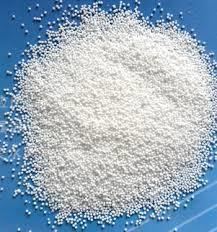Formula Na2CO3·1.5H2O2 Density 2.1 g/cm³ Soluble in Water | Molar mass 157.01 g/mol Appearance white solid | |
 | ||
Related compounds IUPAC ID | ||
Sodium percarbonate is a chemical, an adduct of sodium carbonate and hydrogen peroxide (a perhydrate), with formula 2 Na2CO3•3 H2O2. It is a colorless, crystalline, hygroscopic and water-soluble solid. It is used in some eco-friendly cleaning products and as a laboratory source of anhydrous hydrogen peroxide.
Contents
Structure
At room temperature, solid sodium percarbonate has the orthorhombic crystal structure, with the Cmca crystallographic space group. The structure changes to Pbca as the crystals are cooled below about −30 °C.
Production
Sodium percarbonate was first prepared in 1899 by Russian chemist Sebastian Moiseevich Tanatar (Севастьян Моисеевич Танатар) (7 October 1849, Odessa, Russia – 30 November 1917, Odessa, Russia).
Sodium percarbonate is produced industrially by reaction of sodium carbonate and hydrogen peroxide, followed by crystallization. Also, dry sodium carbonate may be treated directly with concentrated hydrogen peroxide solution. World production capacity of this compound was estimated at several hundred thousand tonnes for 2004. It can be obtained in the laboratory by treating the two substances in aqueous solution with proper control of the pH or concentrations.
Uses
As an oxidizing agent, sodium percarbonate is an ingredient in a number of home and laundry cleaning products, including non-chlorine bleach products such as OxyBoost, OxiClean, Tide laundry detergent, and Vanish. Dissolved in water, it yields a mixture of hydrogen peroxide (which eventually decomposes to water and oxygen) and sodium carbonate ("soda ash"). Many commercial products mix a percentage of sodium percarbonate with sodium carbonate (washing soda). The average percentage of an "Oxy" product in the supermarket is 65 percent sodium percarbonate and 35 percent washing soda. The "ultra boosters" seen on infomercials may contain as much as 80 percent sodium percarbonate. However, sodium percarbonate is less expensive in its pure form and can be adjusted to any percentage the user desires.
2 Na2CO3·3 H2O2 → 2 Na2CO3 + 3 H2O2Sodium percarbonate can be used in organic synthesis as a convenient source of anhydrous H2O2, in particular in solvents that cannot dissolve the carbonate but can leach the H2O2 out of it. A method for generating trifluoroperacetic acid in situ for use in Baeyer–Villiger oxidations from sodium percarbonate and trifluoroacetic anhydride has been reported; it provides a convenient and cheap approach to this reagent without the need to obtain highly concentrated hydrogen peroxide.
